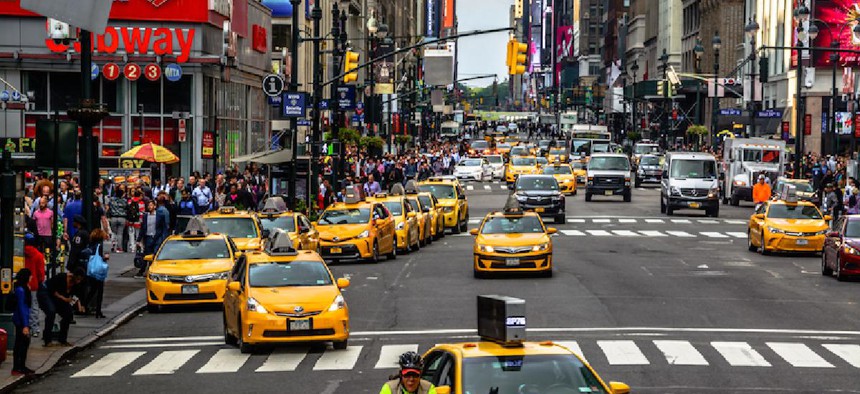Why Uber is in favor of congestion pricing
Earlier this month, Uber threw its support behind the Fix NYC congestion pricing plan proposed by Gov. Andrew Cuomo’s task force. The ridesharing giant, which has previously worked to stifle regulatory legislation in elected bodies across the country, has joined forces with a group of advocacy organizations and unions to form a coalition to promote congestion pricing in New York state’s 2019 budget.

Shutterstock
Earlier this month, Uber threw its support behind the Fix NYC congestion pricing plan proposed by Gov. Andrew Cuomo’s task force. The ridesharing giant, which has previously worked to stifle regulatory legislation in elected bodies across the country, has joined forces with a group of advocacy organizations and unions to form a coalition to promote congestion pricing in New York state’s 2019 budget.
The plan, as announced in January, proposes a daily charge of $11.52 for all passenger cars in Manhattan below 60th Street, and a $2 to $5 surcharge on every taxi and for-hire vehicle ride in a similar area.
While Uber’s support for such a scheme may be surprising, it’s something they’ve backed in theory for at least a year.
“Less traffic means more fares for the companies: the owners as well as their drivers,” said Alex Matthiessen, director of the Move NY campaign, which has advocated for toll reform since 2010 and is also a member of the coalition advocating on Fix NYC’s behalf. He added, “You want to pick up your passenger, discharge them, and pick up the next ride.”
The coalition is planning to spend about half a million dollars in the weeks leading up to the budget’s adoption on April 1, according to Jamie McShane of the Real Estate Board of New York, which is part of the effort. Matthiessen said most of that money will be spent on digital advertising, with some amount also going to direct legislative outreach and potentially television and radio ads as well.
Matthiessen declined to say which coalition members were providing what proportion of that money, but in 2017 Uber outspent the other eight coalition members combined nearly two-to-one on total lobbying in the state (the Real Estate Board of New York and the Hotel and Motel Trades Council came in a distant second and third, respectively). Uber’s massive lobbying investment and legislative influence in New York is undeniable; they outspent Lyft, an Uber competitor, by four-to-one and the Taxicab Service Association 35-to-1 last year.
Assemblyman David Weprin, who represents a suburban district in central Queens, has maintained his long-held opposition to a congestion zone charge, but is open to other measures that specifically target for-hire vehicles.
“There are a number of proposals that came out of (the Fix NYC report) that the governor put in the budget regarding studying placards, studying blocking the block, money to prevent blocking the box, dealing with double parking, dealing with the main cause of congestion in Midtown Manhattan, which is not passenger vehicles coming from Queens, Brooklyn and Westchester into Manhattan, but is basically the tripling and quadrupling of Ubers, Lyfts, black cars, app cars,” Weprin said.
AAA Northeast is also opposed to the Fix NYC plan as it currently exists, citing two problems. First, the predicted increase in vehicle speeds is, according to AAA, too modest to justify the cost to drivers. Second, it doesn’t include toll relief for MTA-controlled outer borough bridges, like the Throgs Neck and Verrazano, to offset the burden of a Manhattan congestion zone or tolls on the East River bridges. That kind of toll relief has been included in previous Move NY proposals that have been developed with AAA’s input.
“If you look at the report, it envisions an imperceptible increase in vehicle speeds from 6.8 mph to 7.4. That’s one of its key measurements of success, and we think a billion dollars is a pretty high price to pay for a less than one mile per hour improvement,” said John Corlett, chairman of AAA Northeast’s legislative committee. “It appears to be another revenue bailout for MTA.”
But Uber maintains that the proposal is the right path forward, for taxis and for-hire vehicles as well as motorists and subway riders.
“The per-trip surcharge for taxi and FHV recommended by Fix NYC could be implemented immediately to begin raising money to fund MTA improvements and change New Yorkers’ behavior,” a spokesperson for Uber said in a statement. “But the only way to address congestion and fully fund the MTA is through a comprehensive congestion pricing plan that is applied to all vehicles.”
Paul Steely White, executive director of Transportation Alternatives, a safe streets advocacy group, applauded Uber for supporting the proposal.
“I have seen them evolve rapidly, of late, as a more evolved company that has more modern values, and a company that also understands its place in a world where mobility is a service, and mobility is multi-modal, and I think they definitely see themselves as part of a car-free or car-light lifestyle,” White said. “It’s definitely strange bedfellows to have Uber and Transportation Alternatives pulling for the same goal, but again, that’s how you make policy change.”
Below is an analysis of the total 2017 state lobbying expenditures by entities that have a direct stake in this year's congestion pricing debate.
[[{"fid":"4141","view_mode":"default","fields":{"format":"default","field_file_image_alt_text[und][0][value]":"2017 state lobbying congestion pricing","field_file_image_title_text[und][0][value]":"2017 state lobbying congestion pricing"},"type":"media","field_deltas":{"1":{"format":"default","field_file_image_alt_text[und][0][value]":"2017 state lobbying congestion pricing","field_file_image_title_text[und][0][value]":"2017 state lobbying congestion pricing"}},"attributes":{"alt":"2017 state lobbying congestion pricing","title":"2017 state lobbying congestion pricing","style":"height: 187px; width: 336px;","class":"media-element file-default","data-delta":"1"}}]]

